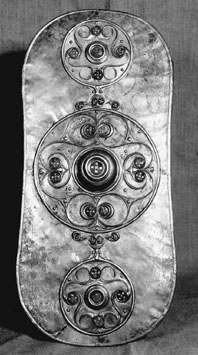

 | Page 287 |  |
In 279 b.c., groups of Celts invaded Greece and attacked the sanctuary of Apollo at Delphi, and may even have sacked it, but they were driven out. Some settled in the Balkans, where the Celtic capitol of Tylis was established somewhere in what is now Bulgaria, while others crossed into Anatolia (now central Turkey), where they were known as Galatae, or Galatians. They proved to be destabilizing intruders until they were defeated in about 233 b.c. by Antigonos I, and later by his son Eumenes II, who in thanks dedicated a sanctuary to Athene Nikephoros where the famous statues of the Dying Gaul and the Gaul Killing Himself and His Wife were first displayed. Known now only from Roman copies made in the second century a.d., these statues originally formed part of a victory complex incorporating, on the temple’s balustrade, a frieze of military trophies that showed weapons and armor that were comparable to those of contemporary central and western Europe.
Many Greek and Roman sources refer to Celts, and some of them are not just geographical descriptions but also refer to physical appearance, social customs, and traits such as boastfulness. Many of these sources were lost in the upheavals of the fifth century a.d. and later following the collapse of the Roman Empire. It was not until the Renaissance and the fifteenth century a.d. that many of these sources once again became available in western and central Europe and were once again widely used by scholars.

An elaborate Battersea shield made in bronze in the first century b.c. by Celts and discovered in London
(The Art Archive/British Museum)
In Britain, this “rediscovery” of past societies led to the recognition of “ancient Britons” in the writings of antiquarians such as that of the first state archaeologist, william camden in Britannia 1586, and a century later, john aubrey’s great but never published work, Monumenta Britannica, begun in 1663. It was observed that classical writers, in writing about Britain, had mentioned, not Celts, but “Pretanni.” In 1723, william stukeley (1687–1765), who helped found the society of antiquaries of london in 1717, entitled his unpublished draft of a study of the great Neolithic stone circle of avebury “The History of the Temples of the Ancient Celts.” Stukeley was both the great recorder of prehistoric antiquities, such as Avebury and Stonehenge, and also the ancestor of modern Druidism and “Celtomania.” edward lhwyd (1660–1709), assistant keeper and later keeper of the ashmolean museum in Oxford, England, the oldest public museum in Europe, identified Welsh, Irish Gaelic, Scottish Gaelic, and Gaulish as different variants of Celtic languages deriving from invaders. This was a brave claim even for its day since the question of the origins and subsequent insular developments of Celtic remains a fraught topic.
There are no surviving pre-Roman texts since presumed Continental early Celtic speakers, although aware of writing, chose to pass wisdom orally, and writing that does exist from northern Italy, Spain, and southern Gaul is restricted
 |  |